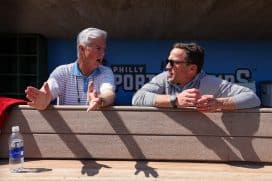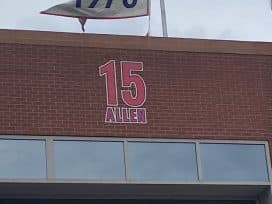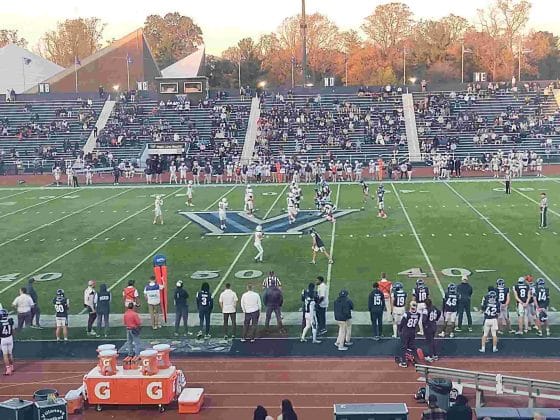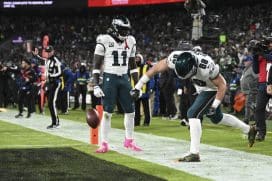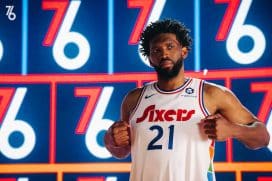Sixers
How the 76ers Were Able to Maximize Their Cap Space
By Scott Cashin, Sports Talk Philly writer
Just like packing a suitcase, the Philadelphia 76ers maximized their cap space during free agency by executing contracts in a certain order.
After shedding Jonathon Simmons’s contract during the draft, the 76ers had only four players under contract (Joel Embiid, Ben Simmons, Zhaire Smith and Jonah Bolden) going into the offseason making a combined $40,379,769 in the 2019-20 season. Faced with a decision to be made on their nine free agents, the team carried cap holds to retain the various levels of Bird Rights on their players including the cap hold on the No. 20 pick in the draft, Matisse Thybulle.
See below:
|
Player |
Type of exception |
Cap hold |
|
Jimmy Butler |
Full Bird |
$30,668,669 |
|
Tobias Harris |
Full Bird |
$22,200,000 |
|
JJ Redick |
Early Bird |
$15,925,000 |
|
Boban Marjanovic |
Full Bird |
$10,500,000 |
|
Mike Scott |
Non Bird |
$5,184,600 |
|
Amir Johnson |
Early Bird |
$3,112,053 |
|
James Ennis III |
Non Bird |
$1,945,698 |
|
TJ McConnell |
Full Bird |
$2,400,780 |
|
Greg Monroe |
Non Bird |
$1,618,486 |
|
Matisse Thybulle |
Rookie Scale |
$2,582,160 |
The presence of these cap holds is what allows the team to exceed the cap to re-sign their own players.
After accounting for all of their cap holds, the team was left in a position of being $27,377,215 over the salary cap.
While the team was only technically committed to $40.3 million of salary, that didn’t tell an accurate story of the team’s free agency options. As players sign with another team, their cap hold is released. As a team signs a player to a contract, that value replaces the cap hold. When the total number of players under contract (including those with exception rights in place) drops under 12, the team is required to carry a rookie minimum level contract ($897,158) for each spot less than 12. If the team immediately renounced all their Bird Rights to the nine players occupying cap holds, they would assume eight minimum salary cap holds (a total of $7,177,261) to bring the roster count to 12 when added to the four existing contracts. $59,897,968 would have been the most space the team could generate without trading or buying out a player already under contract or stashing their rookie overseas.
When news of JJ Redick’s departure surfaced shortly after free agency began, his $15.9 million cap hold was removed, getting the team closer to having usable space ($11,452,215 over the cap at this point). When Jimmy Butler’s cap hold was swapped with Josh Richardson’s contract (see Butler Sign-and-Trade), the team found itself suddenly under the cap by $9,099,878. While Tobias Harris came to terms on a $180 million extension, he agreed to wait to execute the deal until after the team spent its cap space in free agency. Harris placing this trust in the team resulted in the team gaining $8.8 million of spending flexibility (difference between his cap hold of $22.2 million and his base year of $31 million).
Having been engaged in discussions with Al Horford, the team knew it needed to get at least $28 million under the cap to squeeze Horford’s base-year salary. This is where the renouncement of player's rights began. The team and Mike Scott agreed to a deal that fit within the Room Mid-Level Exception requirements. By doing so, they were able to renounce his rights and execute his contract after inking Horford and Shake Milton. In short, by renouncing Boban Marjanovic, Scott, Amir Johnson, James Ennis III, TJ McConnell and Greg Monroe, the team freed up $29,369,946 of usable space. This was enough to fit Horford’s $28 million base year under the cap with just over $2.2 million of space remaining.
The structuring of Horford’s contract was interesting. They could have front-loaded almost $1.5 million more than they did, but it would have prevented them from signing Milton to a deal greater than two years in length. With the rights to eight players in hand, the team made a shrewd calculation to sign Milton using cap space instead of using a Minimum Contract Exception. The benefit is having the ability to retain Milton on a team friendly contract in years three and four. If they hadn’t, they would run the risk of being unable to retain his services after year two given another team offered him a contract they couldn’t match.
Being almost out of usable space at this point, the team begins to sign Harris to his Designated Veterans Extension, Scott to the Room Mid-Level Exception and Kyle O’Quinn, Ennis III and Raul Neto to Veteran Minimum Exception contracts.
Before filling the 14th and 15th roster spots with complimentary veterans making the minimum, the roster stands as follows for the upcoming season.
|
Tobias Harris |
$31,034,4833 |
|
Joel Embiid |
$27,504,630 |
|
Al Horford |
$28,000,0002 |
|
Josh Richardson |
$10,116,576 |
|
Ben Simmons |
$8,113,929 |
|
Mike Scott |
$4,766,814 |
|
Zhaire Smith |
$3,062,760 |
|
Matisse Thybulle |
$2,582,1601 |
|
Kyle O’Quinn |
$2,174,3185 |
|
James Ennis |
$1,845,3015 |
|
Raul Neto |
$1,737,1455 |
|
Jonah Bolden |
$1,698,450 |
|
Shake Milton |
$1,445,6964 |
- Matisse Thybulle carries a 120 percent cap hold for his rookie-scale contract. The number listed is the maximum allowable the team can pay him in 2019-20. The actual contract value could be worth up to 33.3 percent less than the $2.5 million shown.
- Al Horford's contract details are reported as being $28 million, $27.5 million, $27 million and $26.5 million in each of the next four seasons with the last season being only partially guaranteed.
- Tobias Harris agreed to a five-year Designated Veteran Extension worth a reported $180 million. The assumed breakdown of the years starts at just over $31 million in the base year and rises 8 percent each of the subsequent years.
- The actual value of the Shake Milton contract is not yet known. The least it could be worth is the displayed $1,445,696. It is known that space was used to sign him and not the Veteran Minimum Exception. It could be worth a higher dollar value than that which is shown.
- Signed using the Veteran Minimum Contract Exception. Varying contract values between the players is due to differing amounts of service time in the league.

